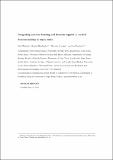Files in this item
Integrating machine learning and decision support in tactical decision-making in rugby union
Item metadata
| dc.contributor.author | Watson, Neil | |
| dc.contributor.author | Hendricks, Sharief | |
| dc.contributor.author | Stewart, Theodor | |
| dc.contributor.author | Durbach, Ian | |
| dc.date.accessioned | 2021-08-02T23:38:21Z | |
| dc.date.available | 2021-08-02T23:38:21Z | |
| dc.date.issued | 2020-08-03 | |
| dc.identifier | 269562787 | |
| dc.identifier | 837ae336-4b2d-4332-bac0-ad7293027722 | |
| dc.identifier | 85089009050 | |
| dc.identifier | 000555245200001 | |
| dc.identifier.citation | Watson , N , Hendricks , S , Stewart , T & Durbach , I 2020 , ' Integrating machine learning and decision support in tactical decision-making in rugby union ' , Journal of the Operational Research Society , vol. Latest Articles . https://doi.org/10.1080/01605682.2020.1779624 | en |
| dc.identifier.issn | 0160-5682 | |
| dc.identifier.other | ORCID: /0000-0003-0769-2153/work/78892098 | |
| dc.identifier.uri | https://hdl.handle.net/10023/23700 | |
| dc.description | Funding: National Research Foundation of South Africa andthe Department of Higher Education and Training via the Teaching and Development Grant (IRMA:29113). | en |
| dc.description.abstract | Rugby union, like many sports, is based around sequences of play, yet this sequential nature is often overlooked, for example in analyses that aggregate performance measures over a fixed time interval. We use recent developments in convolutional and recurrent neural networks to predict the outcomes of sequences of play, based on the ordered sequence of actions they contain and where on the field these actions occur. The outcomes considered are gaining territory, retaining possession, scoring a try, and being awarded or conceding a penalty. We consider several artificial neural network architectures and compare their performance against baseline models. Accounting for sequential data and using field location improved classification accuracy over the baseline for some outcomes. We then investigate how these prediction models can provide tactical decision support to coaches. We demonstrate that tactical insight can be gained by conducting scenario analyses with data visualisations to investigate which strategies yield the highest probability of achieving the desired outcome. | |
| dc.format.extent | 477274 | |
| dc.language.iso | eng | |
| dc.relation.ispartof | Journal of the Operational Research Society | en |
| dc.subject | Classification | en |
| dc.subject | Decision support | en |
| dc.subject | Machine learning | en |
| dc.subject | Neural networks | en |
| dc.subject | Performance analysis | en |
| dc.subject | Rugby union | en |
| dc.subject | GV Recreation Leisure | en |
| dc.subject | HD28 Management. Industrial Management | en |
| dc.subject | QA75 Electronic computers. Computer science | en |
| dc.subject | Management Information Systems | en |
| dc.subject | Marketing | en |
| dc.subject | Strategy and Management | en |
| dc.subject | Management Science and Operations Research | en |
| dc.subject | 3rd-DAS | en |
| dc.subject.lcc | GV | en |
| dc.subject.lcc | HD28 | en |
| dc.subject.lcc | QA75 | en |
| dc.title | Integrating machine learning and decision support in tactical decision-making in rugby union | en |
| dc.type | Journal article | en |
| dc.contributor.institution | University of St Andrews. School of Mathematics and Statistics | en |
| dc.contributor.institution | University of St Andrews. Centre for Research into Ecological & Environmental Modelling | en |
| dc.identifier.doi | 10.1080/01605682.2020.1779624 | |
| dc.description.status | Peer reviewed | en |
| dc.date.embargoedUntil | 2021-08-03 |
This item appears in the following Collection(s)
Items in the St Andrews Research Repository are protected by copyright, with all rights reserved, unless otherwise indicated.

